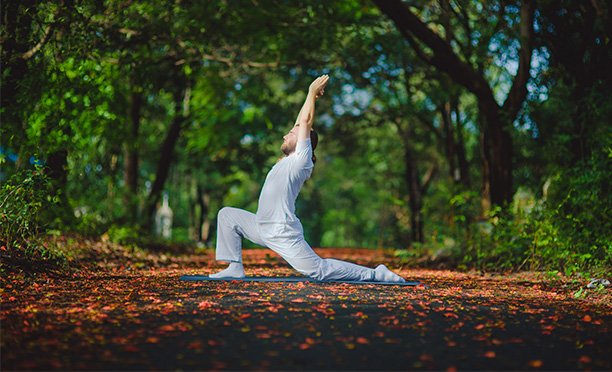Visiting Yoga guru, Swami Purnachaitanya talks life and health
Recently, Sun Health sat down with Swami Purnachaitanya to discuss his perspective on yoga, common assumptions about yoga, self-acceptance, and the role of breathing techniques, and meditation in healing and transformation. Swami is the Director of Programmes and Senior International Trainer with the Art of Living Foundation, a travelling teacher as he is commonly referred to.
Please describe your journey to yoga .Why do you devote your life to this practice and how has it changed you?
Since my childhood I had a desire to live a life of service, making a difference to the people around me, and I also had a keen interest in Eastern traditions and philosophies. Born and brought up in The Netherlands, I used to practise a range of Eastern martial arts. In those martial arts there is also an aspect of breathing techniques, meditation and transcending the mind, but it is limited. I wanted to learn more and I was looking for something authentic, go deeper. When I did the first programmes of the Art of Living, while at high school, I found it so relevant for our day-to-day life, so practical and yet profound, that I knew that I had found what I was looking for. And when I saw that these programmes helped other people also in so many ways, whether it was to improve their health, get rid of stress, improve their relationships, or find more meaning in life, I knew that this is how I would like to serve the world: by teaching these programmes to maximum people.
I have to get this out of the way. You look like Jesus, the Western one in posters and art all over. How do people react to you especially that your teachings are from Eastern origins where Christianity does not really have a huge following?
Yes, it happens quite regularly that people say I look like Jesus. I guess that’s also because the Church somehow chose to give Him a western look. My dress and appearance is actually much more Eastern I would say, as it is an ancient practice of monks to dress like this, and they either shave off all their hair and beard, or keep it long. I guess you can say that whatever they do, they do it 100%! But this is just a uniform you can say, so that people can recognise one as a spiritual guide, nothing more. Of course it is very comfortable also, and as for people’s reaction: they are usually just pleasantly surprised and a little curious!
What exactly does Travelling teacher, Director of Programmes and Senior International Trainer with the Art of Living Foundation entail?
Travelling internationally, as per the local requirements, to conduct various programmes of the Art of Living, including Yoga Teacher Training, Meditation Retreats, Leadership programmes for rural youth and more. I also oversee various service projects, guide our local teams what more initiatives we can take up, and represent the organisation in national and international forums.
Tell us a bit about the tour you are on and which countries you have/will be visiting?
My work in Africa started in November in South Africa, after which I went to Zambia, Zimbabwe, Tanzania, Kenya and now Botswana. After this I will be traveling to Mauritius, back to South Africa for a tour, and then to Uganda, Ivory Coast, and more places. I will be in Africa till at least July or August, and then probably come back again soon after that.
What is your mission as a teacher? Who are you trying to reach and why?
Our programmes target all layers of the society, from villagers and slum dwellers, to the general public, students, professionals, government respresentitives and prison inmates. Transforming the society by strengthening the individual, with the vision of a violence-free, stress-free, prosperous and peaceful world.
Who are the teachers that really inspire you and why?
I used to read different books and see some videos and so on, but when I met Sri Ravi Shankar I knew that I had finally found what I had been looking for: a real living Master, who is authentic and teaches the ancient wisdom in a way that is so relevant to our modern lives, and with such humility and simplicity that everyone can understand it and relate to it. His profound wisdom, put in simple words, and the fact that he encourages all to ask questions and have their own experience, is something rare and beautiful. He cares for all, feels at home with people of all cultures and religions, and honours their traditions, encouraging them to preserve their ways. He has truly embraced the world as his family, and works day and night to make their lives better and this world a more peaceful and beautiful place.
Some of us think we can practise yoga or meditation on our own. How important would you say it is to have a teacher/master/guru?
In the philosophy of Yoga it has always been emphasised that one needs a proper teacher or guru to learn these techniques. Many of the scriptures on Yoga and its techniques often also don’t go into details about techniques – it has to be learnt in person. Nowadays many people feel they can learn from a book or Youtube video, but they forget that a book or video will not be able to guide or correct you. You may think you are doing it properly, while actually you may not, and it may even be harmful if you don’t do it correctly. And if you need someone to guide you when you go to a new city and are lost for directions, would you not need someone all the more if you want to learn about something so subtle as how your mind works, how the consciousness works, and how to realise your true nature?
Share at least three common incorrect assumptions about Yoga?
- You need to be physically fit and very flexible to practice Yoga. Truth is, a good Yoga teacher can guide any student as per their current situation and by doing the right practices, one can become much more fit, healthy and happy. Yoga is for all.
- Yoga means physical exercise. Truth is, the physical asanas (postures and stretches) are only a very small aspect of Yoga. The main practice and teachings of Yoga are about how to keep our mind peaceful, happy and balanced amidst any situations and challenges in life.
- Yoga is a religious practice and cannot be practised if you follow a certain religion. Truth is, Yoga was conceived and developed by the sages of India thousands of years ago as a science to keep the body and mind healthy, and to realise one’s true potential. Stretching your muscles, breathing in the proper manner, and keeping your mind peaceful is not against any religion, and to say so one not only deprives people of something that can greatly improve their lives, it also shows a very unscientific and medieval mindset, as if saying Om, Amen or Shalom would affect anyone’s beliefs. It would be like saying that a Buddhist or Muslim or Hindu cannot use medicines that were invented by Christian monks and scientists in Europe over recent centuries.






